Damping-off in Vegetables
One of the first diseases that vegetable growers are most likely to observe during the growing season is a disease of seeds and seedlings called damping-off. Damping-off can affect numerous vegetable hosts, including beans, brassicas, cucurbits, lettuce, peppers, and tomatoes, and can be a problem in commercial vegetable production, transplant production, and home gardens.
Signs and Symptoms
Symptoms of damping-off may include a failure of seeds to germinate, discoloration and rot of young stems near the soil line (Figures 1 and 2), and wilting, collapse, and death of young seedlings (Figures 3, 4, and 5). Seedlings with damping-off often have discolored and rotting roots. In high-humidity situations, white, fluffy growth of the causal pathogen may develop on infected tissues.
Damping-off typically affects new plantings. It can occur in just a few seedlings, or it may be more extensive, resulting in poor stand establishment (Figure 4) and the need to replant. Damping-off commonly occurs in low-lying areas that have poor drainage and hold water. Damping-off may also be a problem in transplant production (Figure 5).
In all cases, most damage is done to seeds and seedlings during germination and before or after emergence (pre-emergence and post-emergence damping-off, respectively). When older seedlings are attacked by one of the pathogens, stem lesions, which may girdle and kill the plant, are the most common symptoms.
Plants beyond the seedling stage that are affected by damping-off pathogens are typically said to be affected by crown, root, and/or stem rots rather than damping-off, though similar symptoms may occur across all of these diseases.
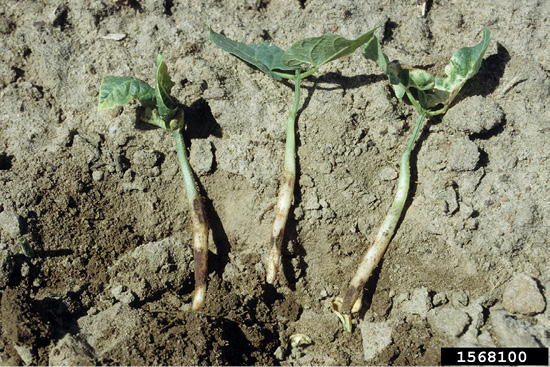
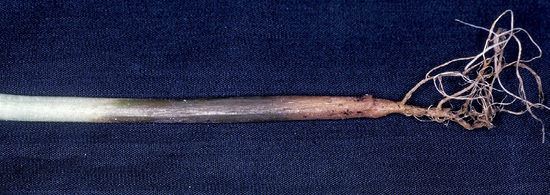
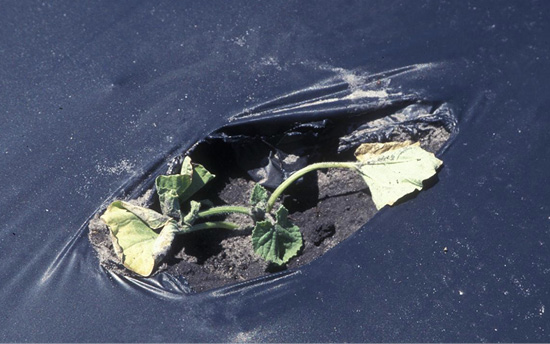
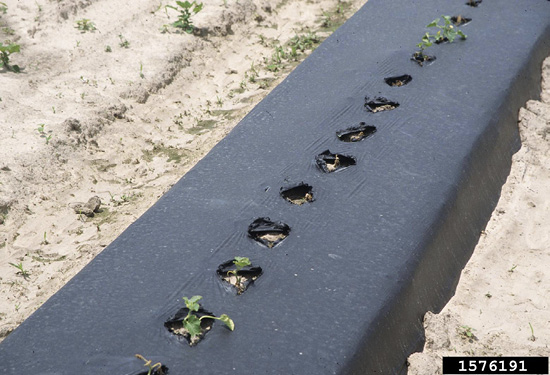
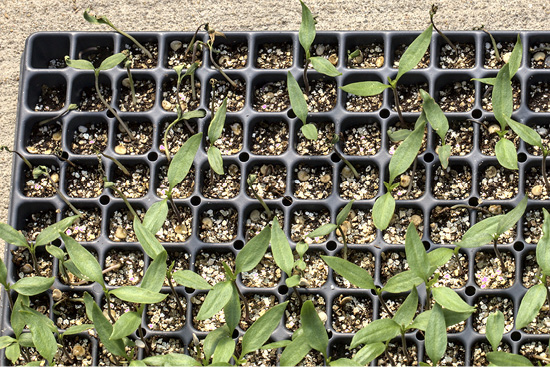
Pathogens and Disease Development
Damping-off can be caused by various fungi, including Rhizoctonia species (spp.) and Fusarium spp., or fungus-like organisms called oomycetes (also called water molds), including Phytophthora spp. and Pythium spp. Many of these pathogens have a broad host range and are capable of infecting numerous vegetable hosts.
Damping-off caused by Fusarium spp. and Rhizoctonia spp. is often a post-emergence damping-off in which the pathogens attack seedlings at the soil line, whereas damping-off caused by Pythium spp. is commonly due to pathogen attack below the soil line. Pythium seed decay is common.
The specific conditions that favor development of damping-off may vary among pathogen genera and among species within a genus. In general, damping-off caused by Phytophthora spp. and Pythium spp. often occurs under cool and wet conditions and in low-lying areas that have poor drainage and hold water, whereas damping-off caused by Fusarium spp. and Rhizoctonia spp. is more common under warm, dry conditions. Cool, wet conditions are especially favorable for damping-off because they also slow plant growth, extending the time seedlings are most susceptible.
The pathogens that cause damping-off are common in soils and persist in the form of survival structures (sclerotia, Rhizoctonia spp.) or reproductive structures (oospores, Pythium spp.) or by colonizing organic matter. They may be spread within and across fields in infested soil or water or on contaminated equipment. Disease occurrence and severity depends on the amount of inoculum and the favorability of environmental conditions present in the field.
Some of the pathogens that cause damping-off can also cause other diseases in mature or fruit-bearing plants, such as buckeye rot (tomatoes), Phytophthora blight (peppers), and bottom rot (lettuce), during the growing season.
Management
Biological Management
Apply biological products (biofungicides) that are effective against damping-off pathogens. Biofungicides labeled for use in various vegetable crops and against some pathogens that cause damping-off are available. However, data on the efficacy of many biofungicides is limited. Some products may specially be labeled for use as seed treatments or allowed for use in organic production. Commercial growers interested in trying biofungicides in their operations can find a comprehensive list of products in the latest edition of the Southeastern U.S. Vegetable Crop Handbook. Home gardeners may be able to purchase some of these products, but biofungicides marketed specifically for use in home gardens may also be available.
When using fungicides, remember: the label is the law. You must completely read product labels before use, and you must follow the label.
Cultural and Environmental Management
Plant in an appropriate site when environmental conditions are favorable for seedling growth, and follow local planting recommendations for each vegetable. To reduce the potential for damping-off, place seeds/seedlings at the recommended planting depth in soils that drain well and when soil temperatures are warm and soils are not wet. Planting on raised beds can help improve soil drainage in the field. Cool, wet soils slow seed germination and plant growth and favor disease development, whereas warm soil temperatures support plant growth.
Planting recommendations, including seed depth and date of planting, are available in the latest edition of the Southeastern U.S. Vegetable Crop Handbook (commercial production) and in MSU Extension Publication 3616 Mississippi Vegetable Gardener’s Guide (home garden production).
Do not overwater. Overwatering provides excess moisture that is favorable for disease development. It is best to water plants in late morning and when soil is dry. Adjust water volume based on plant needs; plants will need more water on sunny days and as they grow.
Do not overcrowd plants. Good air circulation and sunlight can help to reduce conditions that are favorable for development of damping-off. But air circulation and tissue exposure to sunlight are reduced when plants are overcrowded, creating a more suitable environment for disease development. Follow the planting recommendations (e.g., spacing) for each vegetable.
Excess fertility, particularly nitrogen, supports plant growth and, in transplant production, can cause overcrowding. Provide adequate, but not excess, nitrogen and other nutrition, based on production recommendations for the crop.
Maintain appropriate environmental conditions in enclosed structures. When growing transplants or seedlings in enclosed structures, such as greenhouses, maintain temperatures that are favorable for seed germination and plant growth. Use practices and tools, such as ventilation and horizontal fans, that promote air circulation, and be sure that plants receive adequate sunlight. Heating mats may be useful when germinating seeds early in the season when temperatures are not ideal for germination.
Sanitation
Use new or disinfested media, pots, and transplant trays. Some pathogens can persist from season to season in potting media and on pots and transplant trays. Pots and transplant trays that will be reused should be cleaned and then disinfested. A list of disinfectants that may be suitable for use is available in MSU Extension Publication IS1955 Choosing a Disinfectant for Tools and Surfaces in Horticultural Operations. Use new potting media when possible. If potting media must be reused, sterilize it (e.g., steam or heat sterilization) to destroy pathogens that may persist from the previous planting.
Chemical Management (Fungicides)
Purchase fungicide-treated seed or treat non-treated seeds with a fungicide before planting. Using seeds that are pre-treated with a fungicide can help reduce plant losses attributed to damping-off. Pre-treated seeds of some crops and varieties may be available for purchase. Treat purchased seed that is not pre-treated with an appropriate, labeled fungicide before planting.
Apply fungicides that are effective against damping-off pathogens. Fungicides that can be applied to the soil before planting, at planting, or after planting may also be available for use against pathogens that cause damping-off. Fungicides vary in their efficacy against different types of damping-off pathogens. Therefore, it is important to identify the pathogen that is causing the damping-off. Submit samples to the MSU Extension Plant Diagnostic Lab for assistance with pathogen identification. Instructions for sample submission are available in MSU Extension Publication M1562 How to Collect and Package Plant Disease Specimens for Diagnosis.
Information on seed treatments and fungicides for management of damping-off in commercial vegetable production is available in the latest edition of the Southeastern U.S. Vegetable Crop Handbook. Check specific product labels for allowed uses and methods of application. Follow recommended practices, such as fungicide rotation, for resistance management.
Fungicides marketed for vegetables in the home garden are typically not labeled for use as a seed treatment or for management of damping-off. In the home garden, management should focus on cultural and environmental practices and include use of seeds pre-treated with fungicide, when available.
When using fungicides, remember: the label is the law. You must completely read product labels before use, and you must follow the label.
References
Jones, J. B., Zitter, T. A., Momol, T. M., and Miller, S. A. (eds). 2014. Compendium of Tomato Diseases and Pests, second edition. American Phytopathological Society Press, St. Paul, MN. 168 pages.
Keinath, A. P., Wintermantel, W. M., and Zitter, T. A. (eds). 2017. Compendium of Cucurbit Diseases and Pests, second edition. American Phytopathological Society Press, St. Paul, MN. 220 pages.
Pernezny, K. L., Roberts, P. D., Murphy, J. F., and Goldberg, N. P. (eds). 2003. Compendium of Pepper Diseases. American Phytopathological Society Press, St. Paul, MN. 88 pages.
Schwartz, H. F., Steadman, J. R., Hall, R., and Forster, R. L. (eds). 2005. Compendium of Bean Diseases, second edition. American Phytopathological Society Press, St. Paul, MN. 120 pages.
Subbarao, K. V., Davis, R. M., Gilbertson, R. L., and Raid, R. N. (eds). 2017. Compendium of Lettuce Diseases and Pests, second edition. American Phytopathological Society Press, St. Paul, MN. 165 pages.
Additional Resources
Choosing a Disinfectant for Tools and Surfaces in Horticultural Operations (MSU Extension Publication IS1955)
How to Collect and Package Plant Disease Specimens for Diagnosis (MSU Extension Publication M1562)
IR-4 Project Biopesticide Database
Mississippi Vegetable Gardener’s Guide (MSU Extension Publication 3616)
Pesticide Label Databases (MSU Extension Publication 3155)
Plant Disease Sample Submission Form (MSU Extension Publication F1139)
Southeastern U.S. Vegetable Crop Handbook (available online or by contacting your local county Extension office)
This work is partially supported by Crop Protection and Pest Management, Extension Implementation Program, award no. 2021-70006-35580 from the USDA National Institute of Food and Agriculture. Any opinions, findings, conclusions, or recommendations expressed in this publication are those of the author(s) and do not necessarily reflect the view of the U.S. Department of Agriculture.
Publication 3747 (POD-03-22)
By Rebecca A. Melanson, PhD, Associate Extension Professor, Plant Pathology, Central Mississippi Research and Extension Center. Reviewed by Clarissa Balbalian, Diagnostic Laboratory Manager, MSU Extension; Alan Henn, Professor, Plant Pathology, MSU Extension; Jim McAdory, Winston County ANR Extension Agent, MSU Extension; and Margaret McGrath, Plant Pathologist, Cornell University.
The Mississippi State University Extension Service is working to ensure all web content is accessible to all users. If you need assistance accessing any of our content, please email the webteam or call 662-325-2262.






